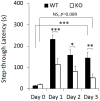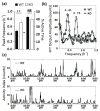Lack of neuronal nitric oxide synthase results in attention deficit hyperactivity disorder-like behaviors in mice
- PMID: 25621792
- PMCID: PMC4523066
- DOI: 10.1037/bne0000031
Lack of neuronal nitric oxide synthase results in attention deficit hyperactivity disorder-like behaviors in mice
Abstract
Nitric oxide (NO) is an important molecule for the proper development and function of the central nervous system. In this study, we investigated the behavioral alterations in the neuronal NO synthase knockout mice (NOS1 KO) with a deficient NO production mechanism in the brain, characterizing it as a potential rodent model for attention deficit hyperactivity disorder (ADHD). NOS1 KO exhibited higher locomotor activity than their wildtype counterparts in a novel environment, as measured by open field (OF) test. In a 2-way active avoidance paradigm (TWAA), we found sex-dependent effects, where male KO displayed deficits in avoidance and escape behavior, sustained higher incidences of shuttle crossings, and higher incidences of intertrial interval crossings, suggesting learning, and/or performance impairments. On the other hand, female KO demonstrated few deficits in TWAA. Molsidomine (MSD), a NO donor, rescued TWAA deficits in male KO when acutely administered before training. In a passive avoidance paradigm, KO of both sexes displayed significantly shorter step-through latencies after training. Further, abnormal spontaneous motor activity rhythms were found in the KO during the dark phase of the day, indicating dysregulation of rhythmic activities. These data indicate that NOS1 KO mimics certain ADHD-like behaviors and could potentially serve as a novel rodent model for ADHD.
PsycINFO Database Record (c) 2015 APA, all rights reserved.
Conflict of interest statement
The authors declare no conflict of interest.
Figures





Similar articles
-
Influence of functional variant of neuronal nitric oxide synthase on impulsive behaviors in humans.Arch Gen Psychiatry. 2009 Jan;66(1):41-50. doi: 10.1001/archgenpsychiatry.2008.510. Arch Gen Psychiatry. 2009. PMID: 19124687
-
Nitric oxide synthase genotype modulation of impulsivity and ventral striatal activity in adult ADHD patients and healthy comparison subjects.Am J Psychiatry. 2011 Oct;168(10):1099-106. doi: 10.1176/appi.ajp.2011.10101446. Epub 2011 Jul 1. Am J Psychiatry. 2011. PMID: 21724667
-
Impairment of neuropsychological behaviors in ganglioside GM3-knockout mice.Biochem Biophys Res Commun. 2011 Mar 25;406(4):524-8. doi: 10.1016/j.bbrc.2011.02.071. Epub 2011 Feb 17. Biochem Biophys Res Commun. 2011. PMID: 21333627
-
Rodent models of attention-deficit/hyperactivity disorder.Biol Psychiatry. 2005 Jun 1;57(11):1239-47. doi: 10.1016/j.biopsych.2005.02.002. Biol Psychiatry. 2005. PMID: 15949994 Review.
-
Involvement of norepinephrine in the control of activity and attentive processes in animal models of attention deficit hyperactivity disorder.Neural Plast. 2004;11(1-2):133-49. doi: 10.1155/NP.2004.133. Neural Plast. 2004. PMID: 15303310 Free PMC article. Review.
Cited by
-
Knock-out of the critical nitric oxide synthase regulator DDAH1 in mice impacts amphetamine sensitivity and dopamine metabolism.J Neural Transm (Vienna). 2023 Sep;130(9):1097-1112. doi: 10.1007/s00702-023-02597-7. Epub 2023 Feb 16. J Neural Transm (Vienna). 2023. PMID: 36792833 Free PMC article.
-
Zinc and Copper Metabolism and Risk of Autism: a reply to Sayehmiri et al.Iran J Child Neurol. 2017 Summer;11(3):66-69. Iran J Child Neurol. 2017. PMID: 28883881 Free PMC article.
-
Alterations of cerebral perfusion and functional brain connectivity in medication-naïve male adults with attention-deficit/hyperactivity disorder.CNS Neurosci Ther. 2020 Feb;26(2):197-206. doi: 10.1111/cns.13185. Epub 2019 Jun 23. CNS Neurosci Ther. 2020. PMID: 31231983 Free PMC article.
-
NOS1 mutations cause hypogonadotropic hypogonadism with sensory and cognitive deficits that can be reversed in infantile mice.Sci Transl Med. 2022 Oct 5;14(665):eabh2369. doi: 10.1126/scitranslmed.abh2369. Epub 2022 Oct 5. Sci Transl Med. 2022. PMID: 36197968 Free PMC article.
-
Effect of vitamin D supplementation on brain waves, behavioral performance, nitric oxide, malondialdehyde, and high-sensitivity C-reactive protein in children with attention deficit/hyperactivity disorder: study protocol for a randomized clinical trial.Trials. 2022 Oct 22;23(1):890. doi: 10.1186/s13063-022-06837-1. Trials. 2022. PMID: 36273218 Free PMC article.
References
-
- American Psychiatric Association. Diagnostic and Statistical Manual of Mental Disorders. 4. Washington, DC: American Psychiatric Association; 2000. text rev.
-
- Ayers NA, Kapas L, Krueger JM. Circadian variation of nitric oxide synthase activity and cytosolic protein levels in rat brain. Brain Res. 1996;707(1):127–130. - PubMed
-
- Bammer G. Pharmacological investigations of neurotransmitter involvement in passive avoidance responding: A review and some new results. Neurosci Biobehav Rev. 1982;6(3):247–296. - PubMed
Publication types
MeSH terms
Substances
Grants and funding
LinkOut - more resources
Full Text Sources
Other Literature Sources
Medical
Research Materials

